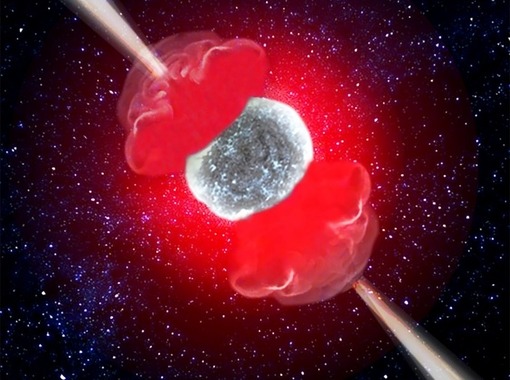An international group of astrophysicists at over 20 research centres all over the world has completed the picture of the processes in place when very massive stars die. The results are published in the latest issue of the journal Nature, on 17 January, 2019. Among the authors of the article is Kasper Elm Heintz, a doctoral student in astrophysics at the University of Iceland.
The end of a star's life can occur in a tranquil manner in the case of low mass stars, such as the Sun. This is not the case, however, for very massive stars, which suffer explosive events so extreme that they can outshine the brightness of the whole galaxy that hosts them.
An international group of research scientists, led by the Institute of Astrophysics of Andalusia (IAA-CSIC), has studied what happens when massive stars, over 25 times more massive than the Sun, die. During this collapse, they suffer a collapse at the core and the nucleus of the star transforms either into a neutron star or a black hole. Shortly after, two polar jets of matter are ejected which drill through the external layers of the star and, once out of the star, produce detectable gamma-rays bursts (the so-called GRB) that are the brightest and most powerful explosion in the universe; visible through most of the observable Universe. Finally, the external layers of the star are ejected, generating a hypernova explosion, tens of times brighter than a typical supernova.
The group's discoveries, published in Nature, are based on studies of the gamma-ray burst GRB 171205A that was detected in December 2017 by the research scientists with the GranTelescopio Canarias, on the island of La Palma. It was detected in a galaxy located 500 million light years from Earth. Gamma-rays are usually short lived, so the astronomers immediately started an intense observing campaign to observe the emerging hypernova from the very early phases on. In fact, with the early observations they managed to obtain the earliest detection of a hypernova to date, less than one day after the collapse of the star.
Drawing of the artist Anna Serena Esposito of a massive star collapsing.

Confirm the existence of a cocoon in dying stars
Although the connection between GRBs and hypernovae has been well established over the last 20 years, since the first studies on it were published, the opposite is not so clear. Several hypernovae are observed each year that do not have associated GRBs.
Through the measurements of the GRB and the formation of the hypernovae, the group confirmed that GRBs can be traced to jets of energy from the cores of massive stars to the outer layers. They realised, furthermore, that a sort of hot cocoon is generated around the jet, as it propagates through the outer layers of the progenitor star. The jet transfers a significant part of its energy to the cocoon and, if it manages to reach the surface of the star, will produce the gamma-ray emission that we know as a GRB. The conclusions indicate that the energy in GRBs is the interaction of the jet, the chemical composition of the star and the cocoon.
Kasper Elm Heintz, doctoral student in astrophysics at the University of Iceland's Faculty of Physical Sciences and one of the authors of the article, is part of the group of scientists that studies gamma-ray bursts in space. He also led the research and follow-up observations of the aftermath of this particular gamma-ray burst through the Nordic Optical Telescope (NOT); partly owned by Iceland.
Kasper says that the research is extremely important as the group was for the first time able to confirm the existence of the cocoon that forms around energy jets, emitted from the nuclei of dying stars. " In this study we estimate the amount of energy lost from the jet into the surrounding cocoon and demonstrate that this additional component could explain why some hypernovae do not show GRBs — the jet simply becomes too weak to pierce the outer envelope of the star because it deposited most of its energy into the cocoon, and will therefore not be able to break free and be observed. This event makes it possible for us to study better the process of the death of massive stars because the light from the glow of the GRB did not influence the light observed by the ground-based telescopes.," he says about the significance of the research.




